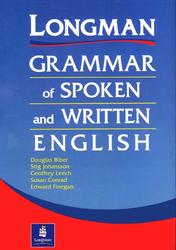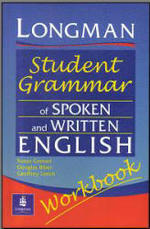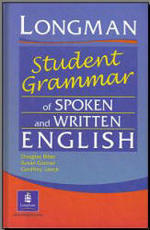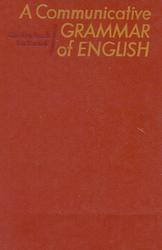Longman English, student grammar of spoken and written, Biber B., Conrad S., Leech G., 2002.
*Examines patterns of use in the news, fiction and academic English *Takes grammar and vocabulary together and looks at how they interact *Is based on the analysis of 40-million words of British and American, written and spoken corpus text *Uses over 3000 examples of real, corpus English to illustrate the points *Uses frequency tables and graphs to make the new findings of this grammar clear
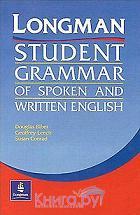
Contents
Preface
Abbreviations, symbols, and
conventions
Grammar Bites in each chapter
1.Introduction: a discourse perspective on grammar
1.1 Introduction
1,3 A corpus-based grammar
1.3 More about language variation
1.4 More detail on the LSWE Corpus 1-5 Overview of the book
1.6 Conventions used in the hook
2.Words and word classes
2.1 Introduction
2.2 What are words?
2.3 Survey of lexical words
2.4 Survey of function words
2.5 Special classes of words
2.6 Word-class ambiguities
3.Introduction to phrases and clauses
3.1 Introduction
3.2 Phrases and their characteristics
3.3 Types of phrases
3.4 A preview of clause patterns
3.5 Clause elements
4.Nouns, pronouns, and the simple noun phrase
4.1 Introduction
4.2 Main types of nouns
4.3 Proper nouns v. common nouns
4.4 Package nouns
4.5 Determiners
4.6 The articles
4.7 Other determiners
4.8 Number: singular and plural
4.9 Case: the genitive
4.10 Gender
4.11 The formation of derived nouns
4.12 Personal pronouns
4.13 Reflexive pronouns
4.14 Demonstrative pronouns
4.15 Indefinite pronouns 4.16 Other pronouns
5. Verbs
5.1 Introduction
5.2 Verb functions and classes
5.3 Semantic categories of lexical verbs
5.4 The most common lexical verbs
5.5 Regular and irregular verb endings
5.6 Verb formation
5.7 Valency patterns
5.8 Multi-word verbs: structure and meaning
5.9 Phrasal verbs
5.10 Prepositional verbs
5.11 Phrasal-prepositional verbs
5.12 Other multi-word verb constructions
5.13 Se
5.14 Have
5.15 Do
5.16 The copula be, and other copular verbs
5.17 Functions of copular verbs
6. Variation In the verb phrase: tense, aspect, voice, and modal use
6.1 Introduction
6.2 Tense and time distinctions: simple present and past tense
6.3 Perfect and progressive aspect
6.4 Perfect aspect in use
6.5 Progressive aspect
6.6 Active and passive voice
6.7 Associations between verbs and passive voice
6.8 Voice and aspect combinations
6.9 Modals and semi-modals
6.10 Personal and logical meanings of modals
6.11 Be going to and used to
6.12 Modals combined with aspect or voice
6.13 Sequences of modals and semi-modals
7. Adjectives and adverbs
7.1 Introduction
7.2 Characteristics of adjectives
7.3 The formation of adjectives
7.4 The function of adverbs
7.5 The formation of adverbs
7.6 Semantic categories of adjectives
7.7 More about attributive adjectives
7.8 More about predicative adjectives
7.9 Other syntactic roles of adjectives
7.10 Syntactic roles of adverbs
7.11 Semantic categories of adverbs
7.12 Comparative and superlative forms of adjectives
7.13 Comparative and superlative forms of adverbs
7.14 Comparative clauses and other degree complements
8.Exploring the grammar of the clause
8.1 Introduction
8.2 Devices of elaboration and condensation
8.3 Subordination and dependent clauses
8.4 Coordination
8.5 Ellipsis and structural condensation
8.6 The subject-verb concord rule
8.7 Verbs as operators
8.8 Negation
8.9 Major types of independent clause
8.10 Declarative clauses
8.11 Interrogative clauses
8.12 Exclamative clauses
8.13 Imperative clauses
8.14 Non-clausal material
8.15 Finite dependent clauses
8.16 Non-finite dependent clauses
8.17 Subjunctive verbs in dependent clauses
8.18 Dependent clauses with no main clause.
9. Complex noun phrases
9.1 Introduction
9.2 Survey of noun modifier types
9.3 Noun phrases with premodifiers and postmodifiers across registers
9.4 Types of premodifiers
9.5 Meaning relationships expressed by noun + noun sequences
9.6 Noun phrases with multiple premodifiers
9.7 Restrictive v. non-restrictive function
9.8 Postmodification by relative clauses
9.9 Postmodification by non-finite clauses
9.10 Postmodification by prepositional phrase
9.11 Postmodification by appositive noun phrases
9.12 Noun phrases with multiple postmodifiers
9.13 Noun complement clauses
9.14 Head nouns with noun complement clauses
10 Verb and adjective complement clauses
10.1 Introduction
10.2 Types of complement clauses
10.3 Grammatical positions of complement clauses
10.4 Discourse functions of that-clauses
10.5 Post-predicate that-clauses
10.6 Verbs controlling extraposed that-clauses
10.7 That-clauses controlled by adjectives
10.8 Discourse choices with (hat-clauses
10.9 Structure and function of wh-clauses
10.10 Post-predicate wh-clauses controlled by verbs
10.11 Interrogative clauses with whether and if
10.12 Overview of infinitive clauses
10.13 Post-predicate to-clauses controlled by verbs
10.14 Subject predicative to-clauses
10.15 Post-predicate to-clauses controlled by adjectives
10.16 Raising
10.17 Extraposed to-clauses
10.18 Raising v. extraposition
10.19 Tb-clause types across registers
10.20 Overview of ing-clauses
10.21 Post-predicate ing-clauses
10.22 Ellipsis and substitution in complement clauses
10.23 Choice of complement clause type
11. Adverbials
11.1 Introduction
11.2 The main classes of adverbials
11.3 Syntactic forms of adverbials
11.4 Positrons of adverbials
11.5 The relationship between adverbials and other clause elements
11.6 Semantic categories of circumstance adverbials
11.7 Extremely common circumstance adverbials in conversation
11.8 Positions of circumstance adverbials
11.9 Additional semantic categories of circumstance adverbial clauses
11.10 Syntactic forms of adverbial clauses
11.11 Positions of adverbial clauses
11.12 Subordinators with circumstance adverbial clauses
11.13 Semantic categories of stance adverbials
11.14 The most common stance adverbials
11.15 Positions of stance adverbials
11.16 Other discourse functions of stance adverbials
11.17 Semantic categories of linking adverbial*
11.18 The most common linking adverbials in conversation and academic prose
11.19 Positions of linking adverbials
12. Word order choices
12.1 Introduction
12.2 Word order
12.3 Fronting
12.4 Inversion
12.5 Existential there
12.6 The verb in existential there clauses
12.7 The notional subject
12.8 Adverbials in existential clauses
12.9 Simple v. complex existential clauses
12.10 Discourse functions of existential clauses
12.11 Dislocation
12.12 Clefting
12.13 Word order choices after the verb
12.14 Summary: syntactic choices in conversation v. academic prose
13.The grammar of conversation
13.1 Introduction
13.2 The discourse circumstances of conversation
13.3 Performance phenomena in conversation
13.4 Non-clausal units
13.5 Ellipsis
13.6 Lexical bundles in speech
13.7 Inserts
Glossary of terms
A-Z list of irregular verbs
Index
Different senses of the word 'word'.
The notion of 'word' is complex, and so it is useful to identify a number of slightly different senses of'word':
• Orthographic words: These are the words that we are familiar with in written language, where they are separated by spaces. For example, They wrote us a letter contains five distinct orthographic words.
• Grammatical words: A word falls into one grammatical word class (or 'part of speech') or another. Thus the orthographic word leaves can be either of two grammatical words: a verb (the present tense -s form of leave) or a noun (the plural at leaf). This is the basic sense of'word' for grammatical purposes, and the one we normally intend in this book.
• Lexemes: This is a set of grammatical words which share the same basic meaning, similar forms, and the same word class. For example, leave, leaves, left, and leaving arc all members of the verb lexeme leave. This is the meaning of'word' that is employed in dictionaries.
Each occurrence of a word in a written or spoken text is a separate token. For example, in the following line of conversation there arc ten separate word tokens:
The birds and the deer and who knows what else, (conv) In contrast to word tokens, word types are the different vocabulary items that occur in a text (such as you would look up in a wordlist). Thus, in the sentence above, there are only eight word types (the, birds, and, deer, who, knows, what, and else), since and and the occur
twice. Notice the token/type distinction applies equally 10 orthographic words, grammatical words, and lexemes. However, our main concern will be with grammatical words, whether as types or as tokens.
In practice, it is not often necessary to distinguish between these senses, as the word 'word' is rarely ambiguous in any given context. But if there is any potential ambiguity the sense intended will be specified.
Купить книгу Longman English, student grammar of spoken and written, Biber B., Conrad S., Leech G., 2002 .
Купить книгу Longman English, student grammar of spoken and written, Biber B., Conrad S., Leech G., 2002 .
Теги: английский язык :: Biber :: Conrad :: Leech
Смотрите также учебники, книги и учебные материалы:
 Английский язык, 5 класс, Верещагина И.Н., Афанасьева О.В. — , 2009. Данная книга я является составной частью учебно-методического комплекта по английскому языку для 5 класса общеобразовательных учреждений и школ … Книги по английскому языку
Английский язык, 5 класс, Верещагина И.Н., Афанасьева О.В. — , 2009. Данная книга я является составной частью учебно-методического комплекта по английскому языку для 5 класса общеобразовательных учреждений и школ … Книги по английскому языку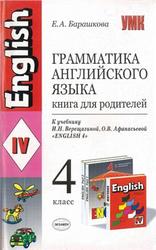 Грамматика английского языка, Книга для родителей, 4 класс, Барашкова Е.А., 2010 — Настоящее пособие представляет собой третий компонент учебного комплекта, состоящего из пяти книг: • Грамматика английского языка. Сборник упражнений. Часть I … Книги по английскому языку
Грамматика английского языка, Книга для родителей, 4 класс, Барашкова Е.А., 2010 — Настоящее пособие представляет собой третий компонент учебного комплекта, состоящего из пяти книг: • Грамматика английского языка. Сборник упражнений. Часть I … Книги по английскому языку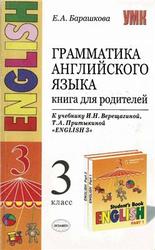 Грамматика английского языка, Книга для родителей, 3 класс, Барашкова Е.А., 2008 — Настоящее пособие представляет собой третий компонент учебного комплекта, состоящего из пяти книг: • Грамматика английского языка. Сборник упражнений. Часть I … Книги по английскому языку
Грамматика английского языка, Книга для родителей, 3 класс, Барашкова Е.А., 2008 — Настоящее пособие представляет собой третий компонент учебного комплекта, состоящего из пяти книг: • Грамматика английского языка. Сборник упражнений. Часть I … Книги по английскому языку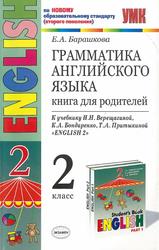 Грамматика английского языка, Книга для родителей, 2 класс, Барашкова Е.А., 2011 — Данное пособие полностью соответствует новому образовательному стандарту (второго поколения) для начальной школы. Оно представляет собой второй компонент учебного комплекта, состоящего … Книги по английскому языку
Грамматика английского языка, Книга для родителей, 2 класс, Барашкова Е.А., 2011 — Данное пособие полностью соответствует новому образовательному стандарту (второго поколения) для начальной школы. Оно представляет собой второй компонент учебного комплекта, состоящего … Книги по английскому языку
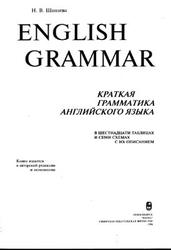 English Grammar, Краткая грамматика английского языка, Шанаева Н.В., 1996 — Работа представляет собой пособие, выполненное в виде компактных таблиц и схем с кратким описанием и примерами по основным разделам грамматики … Книги по английскому языку
English Grammar, Краткая грамматика английского языка, Шанаева Н.В., 1996 — Работа представляет собой пособие, выполненное в виде компактных таблиц и схем с кратким описанием и примерами по основным разделам грамматики … Книги по английскому языку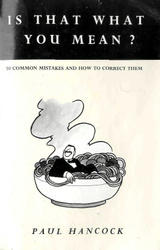 50 типичнейших ошибок у изучающих английский язык — Paul Hancock. 1990. В книге анализируются 50 типичнейших ошибок, которые чаще всего допускают изучающие английский язык (control vs. check, boring … Книги по английскому языку
50 типичнейших ошибок у изучающих английский язык — Paul Hancock. 1990. В книге анализируются 50 типичнейших ошибок, которые чаще всего допускают изучающие английский язык (control vs. check, boring … Книги по английскому языку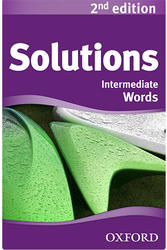 Solutions Intermediate, Student’s Book, 2012 — Solutions 2nd edition Intermediate, Student s Book, 2012. Уровень рассчитан на 100-120 учебных часов, с учетом работы со всеми заданиями. … Книги по английскому языку
Solutions Intermediate, Student’s Book, 2012 — Solutions 2nd edition Intermediate, Student s Book, 2012. Уровень рассчитан на 100-120 учебных часов, с учетом работы со всеми заданиями. … Книги по английскому языку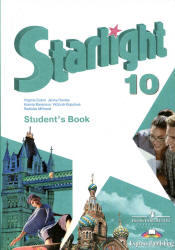 Английский язык, Starlight, 10 класс, Баранова К.М., Дули Д., Копылова В.В., 2012 — Линия УМК Звездный английский (10-11) Учебник (Student’s Book) является основным компонентом УМК Звёздный английский и предназначен для учащихся 10 класса … Книги по английскому языку
Английский язык, Starlight, 10 класс, Баранова К.М., Дули Д., Копылова В.В., 2012 — Линия УМК Звездный английский (10-11) Учебник (Student’s Book) является основным компонентом УМК Звёздный английский и предназначен для учащихся 10 класса … Книги по английскому языку

